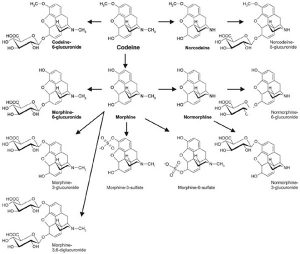Classification of opioids
I. Long-known opiates:
A. Natural opium Opium Tincture of opium Camphor tincture of opium Morphine Codeine
B. Synthetic derivatives
1. Morphine and related substances: Heroin Hydromorphone (Dilaudid) Oxymorphone (Numorphan) Hydrocodone Oxycodone
2. Meperidine and related substances: Meperidine Hydrochloride (Pethidine, Demerol) Anileridine (Leritine) Diphenoxylate Hydrochloride/Atropine sulfate (Lomotil) Fentanyl (Innovar, Sublimaze), its derivatives and “China White” Loperamide (Imodium) Alfaprodine (Nisentil)
3. Other: Pentazocine hydrochloride (Talwin) Butorphanol tartrate (Stadol) Nalbufin Hydrochloride (Nubain) Naloxone (Narcan) Naltrexone (Thehap) Buprenorphine (Buprenex) II. New opiates: Dextromoramide (Palfium) Dezocin (Dalgan) Ketobemidone (Ketogin) Meptazinol Hydrochloride (Metid) Nalmefene (Revex) Pentamorphone Tilidine Hydrochloride (Valoron) Tramadol Hydrochloride (Ultram)
Opioids are classified as controlled substances in the United States.
The structural formulas of some opiates are presented below.
a) Group I. The funds of this group are prohibited from being used for medical purposes in the United States; the potential for abuse is high. These include heroin, marijuana, LSD, peyote, mescaline, psilocybin, tetrahydrocannabinoids, ketobemidone, levomoramide, racemoramide, benzylmorphine, dihydromorphine, morphine methylsulfonate, nicocodeine, nicomorphine, acetylmethadone, phenethylline, tilidine, methaqualone.
b) Group II. The potential for abuse of these drugs and the development of severe mental or physical dependence on them is high. These include certain narcotic substances and drugs containing amphetamines or methamphetamines as the only active component or in combination with each other. These are opium, morphine, codeine, hydromorphone, methadone, pantopone, meperidine, cocaine, oxycodone, anileridine, oxymorphone, pure amphetamines and methamphetamines. The same group includes phenmetrazine, methylphenidate, amobarbital, pentobarbital, secobarbital, ethorphine hydrochloride, phenylacetone, phencyclidine.
c) Group III. The potential for abuse is lower than that of the funds from the previous groups. This includes combinations that include small amounts of certain narcotic substances, as well as non-narcotic psychoactive agents, such as barbituric acid derivatives, except those included in other groups; glutetimide, methiprilone, chlorhexadol, sulfondiethylmethane, sulfonmethane, nalorphine, benzphetamine, chlorphentermine, clortermine, mazindol and fendimetrazine. The same group includes camphor tincture of opium, as well as suppositories containing amobarbital, secobarbital or pentobarbital.
d) Group IV. The potential for abuse is lower than that of the funds of the previous group. Group IV includes barbital, phenobarbital, methylphenobarbital, chloralbetaine, chloral hydrate, ethlorvinol, ethinamate, meprobamate, paraldehyde, methohexital, fenfluramine, diethylpropion, fenteramine, dextropropoxyphen, pentazocine, mebutamate, chlordiazepoxide, diazepam, oxazepam, clorazepate, flurazepam, clonazepam, prazepam, alprazolam. galazepam, temazepam, triazolam and lorazepam.
e) Group V. The potential for abuse of drugs of this group is lower than the means of the previous group. This includes over-the-counter medications that contain a small amount of certain narcotic agents and are usually used against cough and diarrhea.



